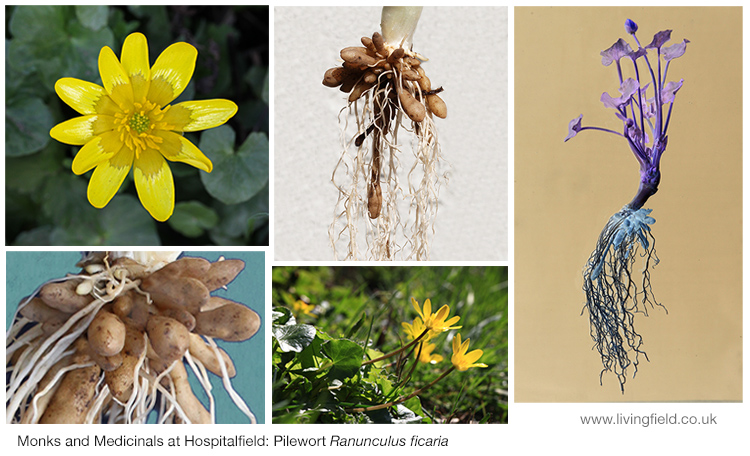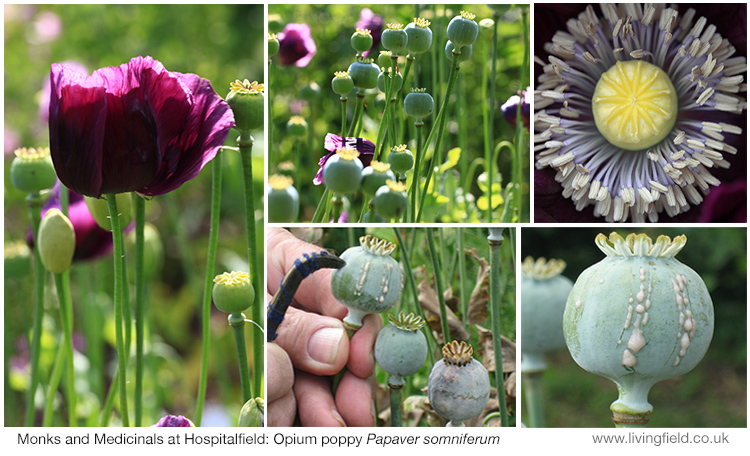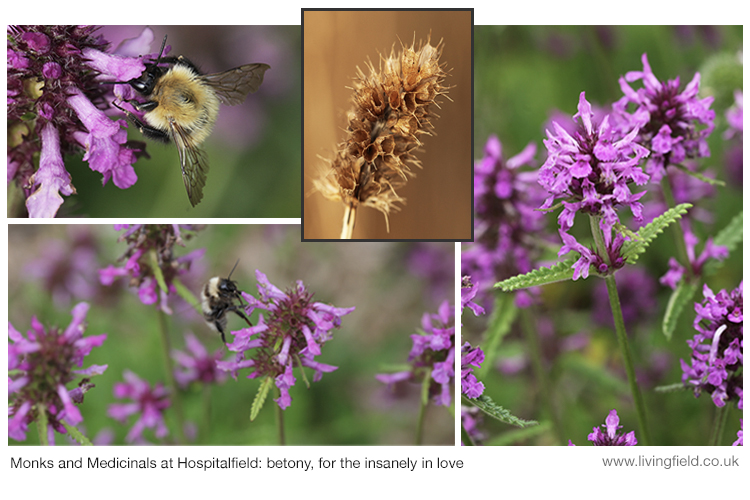A contribution to Monks and Medicinals at the Hospitalfield Beer & Berries Festival 21 August 2021. A brief history of medicinal plants in the ‘western’ world: Theophrastus, Dioscorides and Hildegard. First part of a series listing books and web links referred to on the day.
Introduction
Civilisations sustain themselves on the major food plants – the cereals, legumes, vegetables and the grasses and fodders for livestock – but many other plants have been eaten, less for bulk than for special taste or healing. These are the culinary and medicinal herbs, used throughout human evolution, and more recently here by mesolithic hunters, neolithic farmers, and most people that came after them [1]. Such plants have many uses.
- They complete a varied diet, which (we know from recent research) supports a diverse and healthy microbial community, or microbiome, in the gut.
- Some are placed on the skin as poultices, ointments, wound-herbs, repellants (yarrow, mallow, plantain, kidney vetch, etc.)
- And others are eaten for general health, e.g. the vitamins (culinary herbs, rose hip syrup), or …
- To cure or alleviate specific ailments (most other medicinals).
The gut microbiome? People are used to hearing about the five-a-day – the portions of vegetable and fruit needed to maintain general health – but imagine eating 20 or even 30 different plant species in a day or so. Research has found a link between the range of plants that people consume and the health and functioning of the gut microbiome. If it’s happy and healthy, there’s a chance we might be also. (More on this in Part II.)

The common knowledge of medicinal and poisonous plants is fading western cultures. In some parts of the world, Indigenous Communities continued to curate a diverse range of species and retain the knowledge of how to use them. Yet the existence of many of these communities is under severe threat from land-grabbing, deforestation and mining [2]. This loss of medicinal plants from habitats and cultures is part of the general loss of biodiversity across the earth, including here in Living Field country.
The Living Field project has grown a wide range of culinary herbs and medicinals since the Garden began in 2004. We learned how to grow them from seed and cuttings and observed their roles in the natural food web – most wild and cultivated herbs offer food and shelter for spiders, hoverflies, bees and other invertebrates. We have not extracted any of their products or eaten the plants themselves – unless they are the well known culinary herbs such as thyme, sage, chervil, parsley, dill, garlic, fennel, rosemary and chive.
History of medicinals
The plants that allowed people to farm and settle in Britain and Ireland (botanical not geopolitical regions) did not grow here after the last ice retreated, but were introduced by waves of migrants arriving from Europe and the farther Mediterranean. The cereals – barley and wheat, and emmer, spelt, rye and oats – and the grain legumes, peas and beans, were all brought here in at various times over the previous 6000 years. These settlers found the climate suitable for their crops and supported high yields, as it does today [3].
With some exceptions, such as nettle, plants and animals that provided fibre for cloth and most of the cropped dye plants were also introduced. In contrast, the medicinal plants used over the millenia were a mix of native and introduced. Some of the natives have been preserved at archaeological sites: the finds of pilewort, meadowsweet, wild iris and others show that our neolithic and Bronze Age age ancestors had an understanding of the plants around them [1].
The knowledge of medicinals must have been, for thousands of years, transmitted through the generations by personal example and teaching. The process is risky – people are displaced, communities wither, knowledge is lost – but a more permanent form of transfer eventually appeared.

The Greeks and the Romans
The transmission of botanical knowledge in countries that now form Europe was first based on the writings of ancient Greeks and Romans. Theophrastus (372 to 286 BCE) and Pliny (ca 23-79CE) helped found the systematic study of natural history [4]. One of the first people to list plants of medicinal value was Dioscorides, who wrote De Materia Medica [5] almost 2000 years ago around 50 CE (Common Era).
Dioscorides and his forebears understood that useful medicinals had to be distinguished from poisons and that some of the more potent medicinals also had poisonous properties and had to be dosed correctly. Of the opium poppy Papaver somniferum he writes:
” … a little of it, taken as much as a grain of ervum (a small seed), is a pain-easer, and a sleep-causer, and a digester … but being drank too much it hurts, making men lethargical, and it kills.”
The early botanists wrote mostly in Greek or Latin, languages that were understandable to few other than the very learned, and many of those were raised in religious houses. De Materia Medica was not translated into English until the 1660s [6], so the plants and the knowledge of them spread across Europe in the original languages with the migrations of Benedictines, Cistercians and other monastic houses.

The Monasteries – Monks and Medicinals (and not just monks)
Benedict’s Rules from the 6th Century [7] included care of the unfortunate and care of the sick among the instruments of good works. Cleanliness and bathing were promoted as were medicinals and the herb garden. The plan for monasteries came to include specific areas for the herb garden, the hospital, a place of blood-letting, house of the gardener and an isolation area.
Some of the concepts underlying treatment were not perhaps as scientific as we would expect them today. For quite some time, people – and the plants to cure them – were classified on the balance of four ‘humours’ – hot, cold, wet and dry, a system based on the earlier and widespread ideas of fire, air, water and earth. If you were diagnosed as too hot and wet, then you were treated to counter those humours.
Given all the other feats of technology and engineering the monasteries applied at that time, they must have known more about plants than just their imagined degree of hotness and wetness! Or maybe not.
Hildegard
One of the great polymaths at the time of monastic spread was Hildegard of Bingen (1098-1179), an Abbess based in Germany and attached to a Benedictine house. She wrote, among other books, Physica or Subtleties of the divine qualities of created things [8]. A section of Physica deals with medicinal plants, where (even) she began each description as to how hot, cold, wet or dry the plant was. She did not describe the appearance of the plants, which implies she expected nuns and monks to be able to identify the different species and forms.
Hildegard wrote stunning music for her nuns to sing – most of it recently recorded [8] – and did much else to advance the arts and sciences, so it is difficult to believe that she based her medicinal remedies on these four temperaments. Still, she was about right with oats:
“Oats (avena) are hot, with a sharp taste and strong vapor. Oats are a happy and healthy food for people who are well, furnishing them with a cheerful mind and a pure, clear intellect. It also provides good colour and healthy flesh.”
Physica is a link to medicinal lore that goes back to the Ancient Greeks: on the day of Beer & Berries, plants that she wrote about, such as lungwort, fennel, water mint, plantain, tansy, and yarrow, were all found in and around Hospitalfield garden. Many of her recommendations would resonate well with later herbalists. Yarrow, mallow and plantain are all designated as wound-herbs and she warns against greater celandine (whose sap can scour the skin). But she went a bit to the dark side with one or two of her remedies, invoking magic. Here is what she wrote about betony Stachys officinalis [8]:
For someone who is “conjured by fantastic and diabolic incantations, so that the man is insane with love for the woman or the woman insane with love for the man, they should seek betony …… When found, one leaf should be placed in each nostril, and one under the tongue. One leaf should be held in each hand, and one under each foot. The person should fix his eyes intently on the betony. He should do this until the leaves grow hot on his body. This should be repeated until he is better. This will release him from the madness of his love … “.

The story so far …
People here have used wild and cultivated plants to flavour food and ease pain. There are uncertainties in the prehistoric record over the uses of specific plants, their preparation and how knowledge was transmitted across generations. The written systematic studies that have come down to us from Theophrastus in Greece and later workers, especially Dioscorides, were copied and transported across Europe with the spread of Christian monastic life.
The Abbess Hildegard, over 9 centuries ago, compiled works on natural history that can be read today, and composed choral music that is still sung and now recorded. She was part of the great intellectual and spiritual life in monastic houses. When she was writing and composing – she died 1179 – monasteries and their knowledge of plants was spreading north to Scotland. Part II of this series tells of the contribution they made to agriculture and medicine.
Sources
[1] Plants have been used for purposes other than food and fibre throughout human evolution, see for example: Hardy K (2021) Paleomedicine and the evolutionary context of medicinal plant use. Revista Brasileira de Farmacognosia 31: 1–15 https://doi.org/10.1007/s43450-020-00107-4. Extract from the text “ … the archeological evidence for cured ailments and medicinal plants that cover a wide range of both curative and invasive practices and treatments suggests a high level of confidence and medicinal knowledge deep into human evolutionary time.”
Books that include medicinal plants in Scotland: (a) Dickson C, Dickson J. (2000) Plants and people in ancient Scotland. Tempus Publishing, Stroud, Gloucestershire. (b) Darwin T. (1996, 2008) The Scots Herbal. Berlinn, Edinburgh. (c) Milliken W, Bridgewater S. (2004) Flora Celtica Berlinn, Edinburgh. (d) Beith M. (1995, 2018) Healing threads – traditional medicines of the Highlands and Islands, Berlinn Edinburgh.
[2] Indigenous Knowledge. For general background, try the following and forward links: UNESCO Local and Indigenous Knowledge Systems. There are many articles on indigenous knowledge of plants for medicinal and other uses. A recent article, open access (available free): Camara-Leret, R; Bascompte, J. 2021. Language extinction triggers the loss of unique medicinal knowledge. PNAS 118, https://doi.org/10.1073/pnas.2103683118. For specific regions try searching for ‘location’ ‘indigenous knowledge’ ‘medicinal’, etc.
[3] An article in the Living Field’s Climate and Crops series explains why the climate here is good for crop productivity: The Long Cool Summer.
[4] Theophrastus: try Standford Encyclopedia of Philosophy. Ref – Ierodiakonou, Katerina, “Theophrastus”, The Stanford Encyclopedia of Philosophy (Winter 2020 Edition), Edward N. Zalta (ed.) Pliny the Elder: try Wikipedia.
[5] Background to Dioscorides: try Wikipedia.
[6] De Materia Medica used here: an English Translation by Tess Anne Osbaldeston (2000). Dioscorides. De Materia Medica. ‘Being an Herbal with many other Medicinal Materials written in Greek in the first century of the Common Era – a new indexed version in modern English by TA Osbaldeston and RPA Wood’. IBIDIS Press. Available to buy and there is an online version. [Ed: remarkable, includes a detailed history of previous translations and other sources.]
[7] The Rule of St Benedict , written ca 535-540 CE (but not all sources agree). Various links at Britannica: Benedictine Rule. Wikipedia: Rule of St Benedict.
[8] Hildegard von Bingen. Physica. Translation from the Latin by Priscilla Throop, Illustrations by Mary Elder Jacobsen. Healing Arts Press, Rochester. For Hildegard’s recorded music: see the early music groups Sequentia and Gothic Voices.
Author/contact: geoff.squire@hutton.ac.uk or geoff.squire@outlook.com.
Many of the plants shown here were grown in the Living Field garden near Dundee by Gladys Wright, Jackie Thompson and helpers.
[Updated 28 September 2021 with small alteration and additional reference.]
